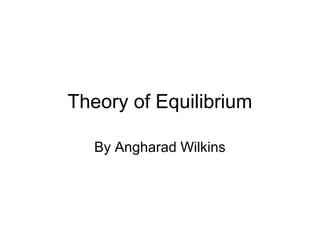Theory of Equilibrium
•Transferir como PPT, PDF•
3 gostaram•39,028 visualizações
Opening Sequence Research Year 12 Media
Denunciar
Compartilhar
Denunciar
Compartilhar

Recomendados
Mais conteúdo relacionado
Mais procurados
Mais procurados (20)
A2 Case Study - The Hunger Games - Genre, Narrative, Representation

A2 Case Study - The Hunger Games - Genre, Narrative, Representation
Under the Skin booklet - a guide, workbook and text book for A-Level film stu...

Under the Skin booklet - a guide, workbook and text book for A-Level film stu...
Film Studies- Paper 1(Session A: Vertigo & Blade Runner)

Film Studies- Paper 1(Session A: Vertigo & Blade Runner)
Destaque
Destaque (20)
Semelhante a Theory of Equilibrium
Semelhante a Theory of Equilibrium (20)
Mais de Angharad Wilkins
Mais de Angharad Wilkins (20)
What have you learned from your Audience Feedback?

What have you learned from your Audience Feedback?
Theory of Equilibrium
- 1. Theory of Equilibrium By Angharad Wilkins
- 2. Tzvetan Todorov simplified the idea of narrative theory while also allowing a more complex interpretation of film texts with his theory of Equilibrium and Disequilibrium. This is split into five stages…
- 3. 1. A state of equilibrium. When everything is as it should be in a state of equal balance between powers of any kind, where equality of importance or effect exists among the various parts of any complex unity.
- 4. 2. A disruption of that order by an event. (disequilibrium)
- 5. 3. A recognition that the disorder has occurred.
- 6. 4. An attempt to repair the damage of the disruption.
- 7. 5. A return or restoration of a NEW equilibrium at the end of the narrative.
- 8. In these stages, narrative is not seen as a linear structure but a circular one. The narrative is driven by attempts to restore the equilibrium. However, the equilibrium attained at the end of the story is not identical to the initial equilibrium.
- 9. Todorov argues that narrative involves a transformation. The characters or the situations are transformed through the progress of the disruption.
- 10. The disruption itself usually takes place outside the normal social framework, outside the 'normal' social events (e.g., a murder happens and people are terrified or someone vanishes and the characters have to solve the mystery).
- 11. This type of narrative structure is very familiar to us and can be applied to many ‘mainstream’ film narratives.
